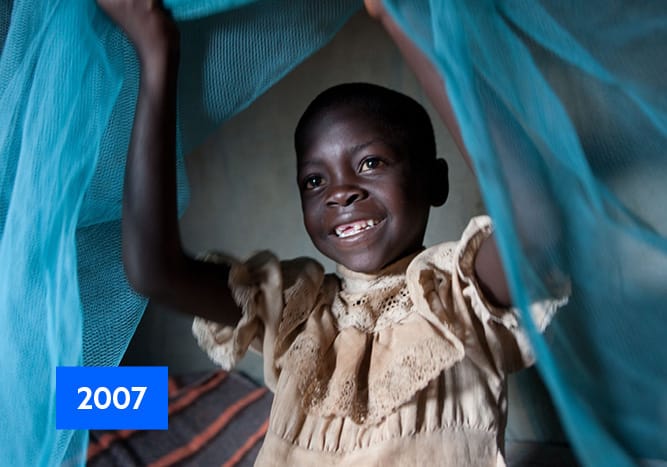Global malaria community scale up and distribution of insecticide-treated mosquito nets helped save and protect millions from malaria
The RBM Partnership to End Malaria is leading the global malaria community in celebrating the milestone of 2 billion insecticide-treated mosquito nets (ITNs) delivered worldwide since 2004.
The development and scale up of these nets are responsible for 68% of the malaria cases prevented in Africa since 2000, contributing to global efforts that saved more than 7 million lives and prevented more than 1 billion malaria cases.
A new video highlights the global collaboration it took to boost funding, pioneer, produce, and deliver the insecticide-treated mosquito nets to millions of families around the world living at risk of malaria, a preventable disease that kills a child every 2 minutes.
The film follows the journey of one of the life-saving mosquito nets passed among representatives from the global malaria community including advocates, a scientist, global leaders and malaria-endemic country health workers to reach a family in Nampula, Mozambique, one of 5 countries with the highest burden of malaria. It also features a classroom of young women in Nyanza Province, Kenya, including Clementina Akinyi. Ms Akinyi, now in her last year of high school, grew up sleeping under insecticide-treated mosquito nets, and was photographed as a young child under a mosquito net – an image which became iconic for the fight against malaria.

According to the latest World Malaria Report, between 2010 and 2018, the number of pregnant women and children under 5 in sub-Saharan Africa who slept under an insecticide-treated net more than doubled, up from 26% to 61%. Each net is typically effective for up to 3 years and 20 washes and, on average, protects two people simultaneously.
Key initiatives driving this progress include The Global Fund to Fight AIDS, Tuberculosis and Malaria and the U.S. President’s Malaria Initiative (PMI), which purchased and worked with malaria-endemic countries and partners to distribute 1.13 billion and 400 million insecticide-treated mosquito nets, respectively. Many other governments, notably the UK, and organisations, including UNICEF, International Federation of the Red Cross and Red Crescent Societies (IFRC), the World Bank, the UN Foundation’s Nothing But Nets initiative and Against Malaria Foundation, also made significant contributions to the 2 billion net milestone.
Dr Tedros Adhanom Ghebreyesus, Director General, World Health Organization (WHO), says:
“Insecticide-treated nets have saved lives, prevented suffering and brought us 2 billion steps closer to our vision of a malaria-free world. With country leadership and global partnership, they will continue to play a vital role in fulfilling that vision.”
Dr Abdourahmane Diallo, CEO, RBM Partnership to End Malaria, comments:
“The milestone of delivering 2 billion life-saving nets is a hallmark example of effective global partnership and sustained commitment over the past two decades. As we enter a new decade, we must now step up action to meet the ambitious global targets of further reducing malaria deaths and cases significantly by 2030. Political commitment and engagement from all levels of society will be crucial to ensure we reach those most vulnerable – pregnant women and children under 5 in sub-Saharan Africa – who still suffer from malaria with life-saving mosquito nets. Equally, we need to continue investing in developing, testing and scaling up nets with new insecticides and active ingredients to stay ahead of the evolving mosquito.”

Dr Marijke Winroks, Chief Staff, The Global Fund to Fight AIDS, Tuberculosis and Malaria, and RBM Partnership to End Malaria board member adds:
“This is a great milestone. With increased domestic and international investment, we can help close the gap and make sure everyone at risk for malaria has an insecticide-treated net – breaking the transmission cycle and helping more countries on the path to elimination.”
Clementina Akinyi, Kenyan schoolgirl featured in the film, explains:
“I don’t fall sick because I’m using the nets. Me and my sister are now champions for mosquito nets, and we are now advising people at school to use the nets. I advise everyone to use nets to prevent malaria, because malaria is a deadly disease.”
While current evidence suggests that nets treated with pyrethroid insecticides continue to be effective against the mosquito, resistance to pyrethroids – the only insecticide class currently used in ITNs – is widespread and highest in the WHO African Region.
To combat insecticide resistance, partners are developing, testing and scaling up nets with new insecticides and harnessing data to better target where to distribute current and new nets. Some of the new nets, which include combinations of insecticides and other active ingredients, have been approved by WHO while others are being piloted to build the epidemiological evidence needed for their public health value to inform WHO policy recommendations and to assess the cost-effectiveness of the nets under pilot conditions.
The Innovative Vector Control Consortium (IVCC) leads implementation of the pilot New Nets Project which began in 2019 in Burkina Faso and will expand in 2020 to Côte d’Ivoire, Mali, Mozambique, Nigeria and Rwanda. The pilot project is funded by the Global Fund and Unitaid. The Bill & Melinda Gates Foundation and U.S. Agency for International Development are providing supplementary funding. Funding for PMI in 2020 includes an additional US$15 million to invest in the use of mosquito nets treated with new types of insecticides. And, in October 2019, MedAccess and the Bill & Melinda Gates Foundation announced an agreement with a mosquito net manufacturer to accelerate the availability of 35 million new nets, which is expected to help lower prices and further increase the use of these tools.
Between 2006 and 2017, the mosquito net market increased fivefold with prices falling from approximately $4.50 to $2, greatly increasing value for money and significantly expanding net coverage from 5.5 million in 2004 to almost 200 million in 2018.

